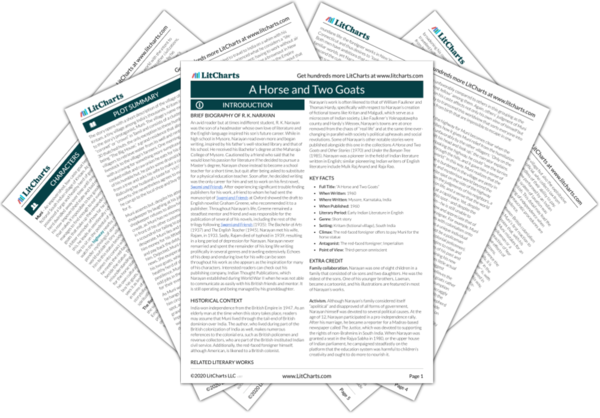The most important symbol in the story is the horse and warrior statue on whose pedestal Muni enjoys sitting and watching the highway. The warrior statue represents Kalki, the final avatar of the Hindu god Vishnu, who will arrive at the end of the Kali Yuga (or the darkest age of humanity) as a messiah to save the virtuous and destroy the hopelessly benighted world and its ignorant, amoral people. The horse statue at Kalki’s side alludes to traditional religious iconography of Kalki, in which he is shown riding a white steed and brandishing a flaming sword. In the story, the statue represents a facet of Indian culture that deals with Hindu spirituality and storytelling in which the notion of cyclical time is essential. The myth of Kalki himself and much of Hindu mythology, in fact, relies on the notion of cyclical time; in the Kalki myth, the messiah must end the Kali Yuga and return the world to the first age, Satya Yuga (the age of truth), thereby restarting the cycle of time. In fact, the statue’s appearance even hints at this cyclical conception of time in that the horse’s tail appears as a loop. These qualities align the statue with Muni himself, who also represents these facets of Indian culture.
The fact that the foreigner believes he can purchase the statue, and his condescending assumption that Muni is merely a “peddler” desperate to sell the statue to a wealthy Westerner, signifies the foreigner’s alignment with American neocolonialism, materialism and conceptions of linear time in which time is a valuable, finite resource. The statue, which is an invaluable artifact that has enormous historical, cultural and sentimental significance, is effectively stripped of these non-monetary forms of value when the foreigner believes he is purchasing the statue for 100 rupees, pries it off its pedestal and packs it into his station wagon. Despite its significance, the foreigner sees the horse statue as merely a “pretty object” he will show off to his friends at cocktail parties. At the end of the story, the foreigner drives off with the statue, still unaware of its multifaceted significance, regardless of Muni’s attempt to narrate its mythology to him. The fact that the foreigner believes that he can purchase the statue (when, in fact, he is stealing it) demonstrates that, despite traveling half a world away to expose himself to other civilizations, he is unable to appreciate the beauty and nuance of Indian culture because he sees it through the narrow lens of his own cultural milieu in which money talks, time is in short supply and one’s acquisition of material objects is the primary concern.
The foreigner’s ignorance, selfishness and materialism seem to suggest the statue’s reference to the darkness of the Kali Yuga and the need for Kalki, the messiah, to return the world to the Satya Yuga. Another detail that relates to the degradation of the Kali Yuga are the “jewels” on the chest of the warrior, which the narrator describes as “faded blobs of mud” but which Muni remembers as once “shining like the nine gems” of Hindu astrology, which correspond with the nine planets. The statue’s gradual degradation (and the degradation of the jewels) parallels the deterioration of the world as it sinks further and further into the abyss of the Kali Yuga.
The Kalki Statue Quotes in A Horse and Two Goats
“I don’t want to seem to have stopped here for nothing. I will offer you a good price for this," he said, indicating the horse. He had concluded without the least doubt that Muni owned this mud horse. Perhaps he guessed by the way he sat at its pedestal, like other souvenir-sellers in this country presiding over their wares.
"This is our guardian, it means death to our adversaries. At the end of Kali Yuga, this world and all other worlds will be destroyed, and the Redeemer will come in the shape of a horse called 'Kalki'; this horse will come to life and gallop and trample down all bad men… [T]he oceans are going to close over the earth in a huge wave and swallow us—this horse will grow bigger than the biggest wave and carry on its back only the good people and kick into the floods the evil ones.”
“I assure you that this will have the best home in the USA. I’ll push away the bookcase, you know I love books and am a member of five book clubs…the TV may have to be shifted too… I’m going to keep him right in the middle of the room. I don’t see how that can interfere with the party––we’ll stand around him and have our drinks.”
“Lend me a hand and I can lift off the horse from its pedestal after picking out the cement at the joints. We can do anything if we have a basis of understanding” … He flourished a hundred-rupee currency note… The old man now realized that some financial element was entering their talk. He peered closely at the currency note, the like of which he had never seen in his life… He laughed to himself at the notion of anyone coming to him for changing a thousand- or ten-thousand-rupee note.












